| |
|
I always look forward to coming back to
Kettlebaston. It is likely that anyone who knows the
churches of Suffolk well will have Kettlebaston among
their favourites. The setting is delectable, in the
remote Suffolk hills between Hadleigh and Stowmarket. The
building is at once elegant and interesting, the interior
memorable, but most fascinating of all perhaps is the
story behind the way it is today.
In 1963, in the thirty-third year of his incumbency as
Rector of the parish of Kettlebaston, Father Harold Clear
Butler sent a letter to a friend. "You are
right,"he wrote. "There is no congregation any
more." In failing health, he relied on the family of
a vicar who had retired nearby to carry out the
ceremonies of Easter week that year. In 1964, Father
Butler himself retired, and an extraordinary episode in
the history of the Anglo-Catholic movement in Suffolk
came to an end.
There may have been no congregation, but St Mary at
Kettlebaston was a shrine, to which people made
pilgrimages from all over England. Here was the
liturgically highest of all Suffolk's Anglican churches,
where Father Butler said the Roman Mass every day,
celebrated High Mass and Benediction on Sunday, dispensed
with churchwardens, flouted the authority of the Anglican
diocese by tearing down state notices put up in the
porch, refused to keep registers, and even, as an
extreme, ignored the office of the local Archdeacon of
Sudbury. An entry from the otherwise empty registers for
October 2nd 1933 reads Visitation of Archdeacon of
Sudbury. Abortive. Archdeacon, finding no churchwardens
present, rode off on his High Horse!
Father Butler came to this parish when the Anglo-Catholic
movement was at its height, and survived into a poorly
old age as it retreated, leaving him high and dry. But
not for one moment did he ever compromise.
Kettlebaston church is not just remote liturgically. You
set off from the vicinity of Hadleigh, finding your way
to the back of beyond at Brent Eleigh - and then beyond
the back of beyond, up the winding roads that climb into
the hills above Preston. Somewhere here, two narrow lanes
head north. One will take you to Thorpe Morieux, and one
to Kettlebaston, but I can never be sure which is which,
or even if they are always in the same place. Finding
your way to this, one of the most remote of all Suffolk
villages, can be like finding your way into Narnia. Once
in the village, you find the church surrounded by a high
yew hedge, through which a passage conducts a path into
the graveyard. On a buttress, a statue of the Coronation
of the Queen of Heaven sits behind a grill. It is a copy
of an alabaster found under the floorboards during the
1860s restoration. The original is now in the British
Museum.
One Anglo-catholic tradition that has not been lost here
is that the church should always be open, always be
welcoming. You enter through the small porch, perhaps not
fully prepared for the wonders that await. The nave you
step into is light, clean and well-cared for. There is no
coloured glass, no heavy benches, no tiles. The brick
floor and simple wooden chairs seem as one with the air,
a perfect foil for the rugged late Norman font, and the
rich view to the east, for the fixtures and fittings of
the 20th Century Anglo-Catholic tradition survive here in
all their splendour.
The two major features are the rood screen
and the high altar. The rood screen is the work of
several people, having been added to over the years by a
roll-call of prominent Anglo-Catholic artists. It was
designed by Ernest Geldart in the 1880s. It was painted
by Patrick Osborne in 1949, apart from the figures, which
are the work of Enid Chadwick in 1954. They are: St Felix
as a bishop holding a candle, St Thomas More in regalia,
St Thomas of Canterbury with a sword through his mitre,
St John Fisher as a bishop holding a book, St Alban in
armour and St Fursey holding Burgh Castle.
 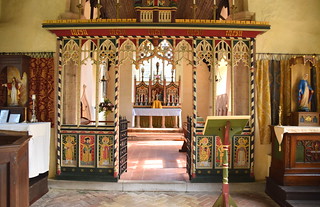 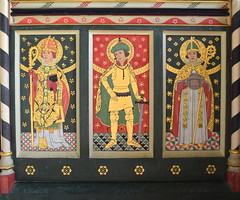
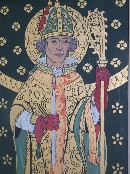 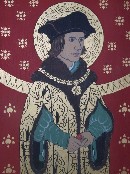 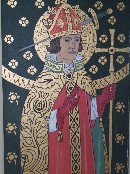 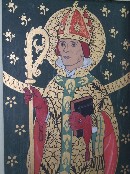 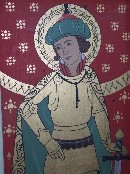 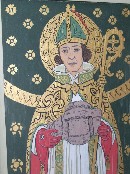
To one side, the Sacred Heart altar bears
the original stone mensa from the high altar. The table
itself is the Stuart Communion table. To the other, a
Lady altar. All of these are either gifts or rescued from
redundant Anglo-Catholic churches elsewhere. The elegant
grill in front of the rood loft stairs is by Ninian
Comper. Stepping through into the chancel is a reminder
of how the clearance of clutter can improve a liturgical
space. Here, the emptiness provides a perfect foil for
the massive altar piece. The altar itself was the gift of
Miss Eleanor Featonby Smith, consecrated by the Bishop of
Madagascar in 1956, in one of those ceremonies conducted
in the labyrinthine underworld of the Anglo-catholic
movement. The altar sports what is colloquially referred
to as the Big Six - the trademark six candlesticks of an
Anglo-catholic parish. Behind them, the rich reredos is
also by Ernest Geldart, and was also painted by Patrick
Osborne.
At the west end of the nave is a display case holding
facsimiles of the Kettlebaston alabasters, an oddly
prosaic moment. But Kettlebaston's medieval past is not
entirely rebooted, for the chancel was sensitively
restored by Ernest Geldart in 1902 with none of the
razzmatazz of his church at Little Braxted in Essex. The
east window was rebuilt to the same design as the
original, as was the roof. The late 13th Century piscina
and sedilia are preserved, and on the north side of the
chancel survives an impressive tomb recess of about the
same date. The sole monument is to Joan, Lady Jermyn, who
died in 1649. Her memorial is understated, and its
inscription, at the end of the English Civil War and the
start of the ill-fated Commonwealth, is a fascinating
example of the language of the time. Is it puritan in
sympathy, or Anglican? Or simply a bizarre fruit of the
ferment of ideas in that World Turned Upside Down? Within
this dormitory lyes interred ye corpps of Johan Lady
Jermy it begins, and continues whose arke after
a passage of 87 yeares long through this deluge of
teares... rested upon ye mount of joye. And then the
verse:
Sleepe sweetly, Saint. Since thou wert
gone
ther's not the least aspertion
to rake thine asshes: no defame
to veyle the lustre of thy name.
Like odorous tapers thy best sent
remains after extinguishment.
Stirr not these sacred asshes, let them rest
till union make both soule & body blest.
Not far off, and from half a century
earlier, a rather more cheerful brass inscription
remembers that:
The corpse of John Pricks wife lyes
heere
The pastor of this place
Fower moneths and one and thirty yeerr
With him she ran her race
And when some eightye yeres were past
Her soule shee did resigne
To her good god in August last
Yeeres thrice five hundredth ninety nine.
And yet, you notice, we never learn her
name. Above, the roofs drip with hanging paraffin lamps,
the walls have their candle brackets, for this little
church still has no electricity. You sense the attraction
of Benediction on a late winter afternoon.
St Mary is loved and cared for by those who
worship in it. There are rather more of them than in
Father Butler's final days, but they are still a tiny,
remote community. Since 1964, they have been part of a
wider benefice, and must toe the Anglican mainstream
line, as at Lound. But also, as at Lound, the relics of
the Anglo-Catholic heyday here are preserved lovingly,
and, judging by the visitors book, it is not just the
regular worshippers who love it, for Anglo-Catholics from
all over England still treat it as a goal of pilgrimage.
I remember sitting in this church on a bright spring
afternoon some twenty years ago. I'd been sitting for a
while in near-silence, which was suddenly broken by the
clunk of the door latch. Two elderly ladies came in. They
smiled, genuflected towards the east, and greeted me.
Together, they went to the Sacred Heart altar, put a
bunch of violets in a vase on it, and knelt before it.
The silence continued, now with a counterpoint of
birdsong from the churchyard through the open door. Then
they stood, made the sign of the cross, and went out
again. Father Butler looked on and smiled, I'm sure.
Simon
Knott, October 2018
Follow these journeys as they happen at Last Of England
Twitter.
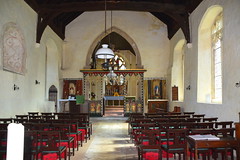 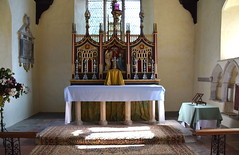 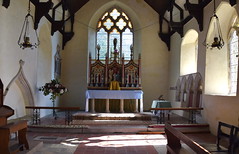
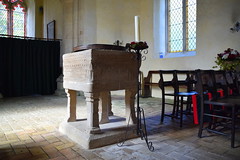 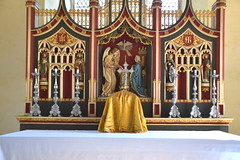 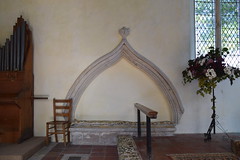
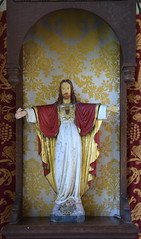 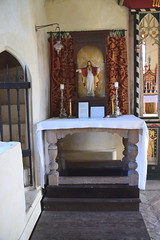 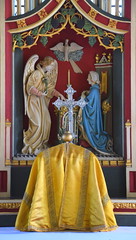 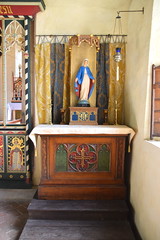 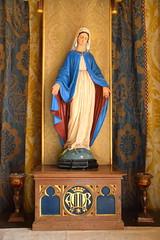
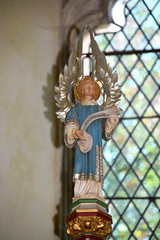  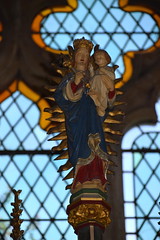 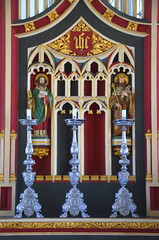 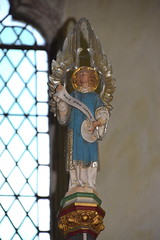
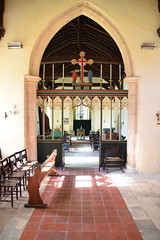  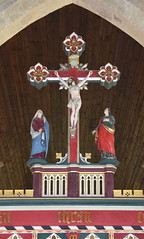 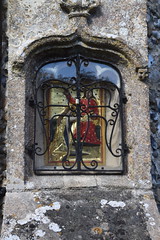 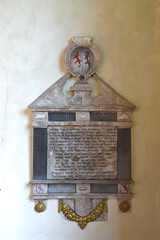
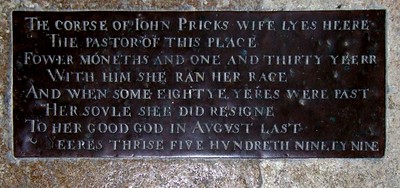
| |
| |
|
|
|
|
|
|
|
| |
|
|
|
|
|
|
|
|
The Churches of East
Anglia websites are
non-profit-making, in fact they
are run at a loss. But if you
enjoy using them and find them
useful, a small contribution
towards the costs of web space,
train fares and the like would be
most gratefully received. You can
donate via Paypal.
|
|
|
|
|
|
|
|
|
|
|
|
|
|
|
|
|
|
|
|
|
|
|
|
| |
|
|
|
|
|
|
|
|
|
|
|
|
|
|
|
|
|

